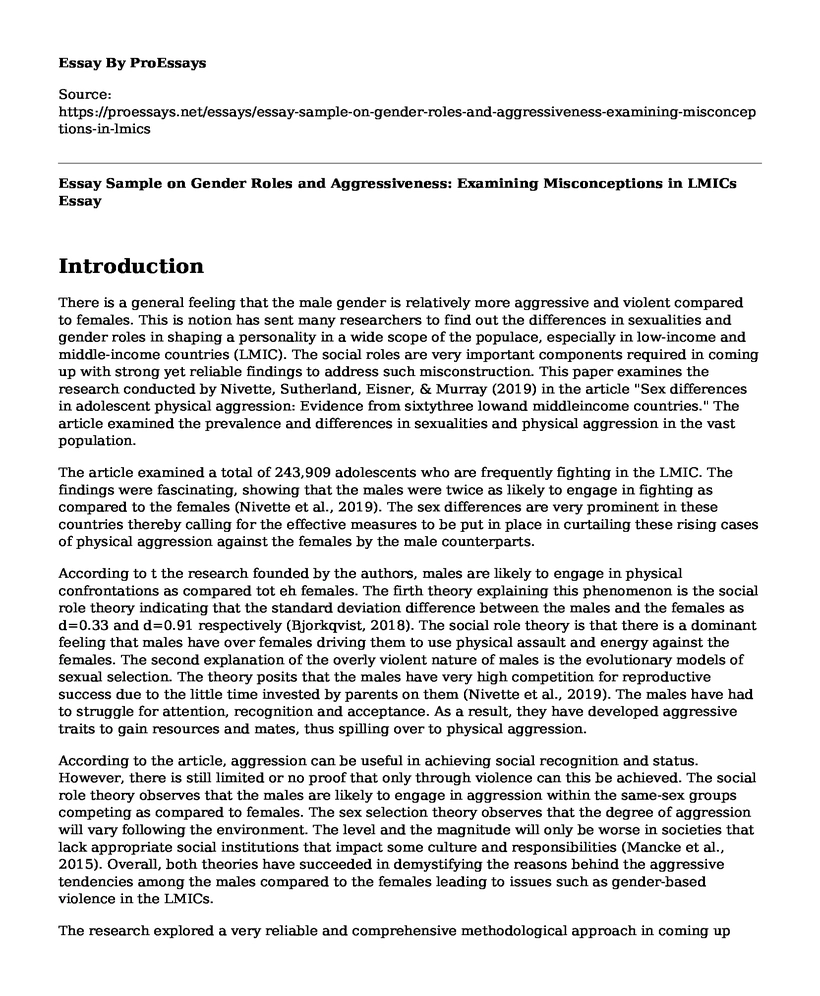Introduction
There is a general feeling that the male gender is relatively more aggressive and violent compared to females. This is notion has sent many researchers to find out the differences in sexualities and gender roles in shaping a personality in a wide scope of the populace, especially in low-income and middle-income countries (LMIC). The social roles are very important components required in coming up with strong yet reliable findings to address such misconstruction. This paper examines the research conducted by Nivette, Sutherland, Eisner, & Murray (2019) in the article "Sex differences in adolescent physical aggression: Evidence from sixtythree lowand middleincome countries." The article examined the prevalence and differences in sexualities and physical aggression in the vast population.
The article examined a total of 243,909 adolescents who are frequently fighting in the LMIC. The findings were fascinating, showing that the males were twice as likely to engage in fighting as compared to the females (Nivette et al., 2019). The sex differences are very prominent in these countries thereby calling for the effective measures to be put in place in curtailing these rising cases of physical aggression against the females by the male counterparts.
According to t the research founded by the authors, males are likely to engage in physical confrontations as compared tot eh females. The firth theory explaining this phenomenon is the social role theory indicating that the standard deviation difference between the males and the females as d=0.33 and d=0.91 respectively (Bjorkqvist, 2018). The social role theory is that there is a dominant feeling that males have over females driving them to use physical assault and energy against the females. The second explanation of the overly violent nature of males is the evolutionary models of sexual selection. The theory posits that the males have very high competition for reproductive success due to the little time invested by parents on them (Nivette et al., 2019). The males have had to struggle for attention, recognition and acceptance. As a result, they have developed aggressive traits to gain resources and mates, thus spilling over to physical aggression.
According to the article, aggression can be useful in achieving social recognition and status. However, there is still limited or no proof that only through violence can this be achieved. The social role theory observes that the males are likely to engage in aggression within the same-sex groups competing as compared to females. The sex selection theory observes that the degree of aggression will vary following the environment. The level and the magnitude will only be worse in societies that lack appropriate social institutions that impact some culture and responsibilities (Mancke et al., 2015). Overall, both theories have succeeded in demystifying the reasons behind the aggressive tendencies among the males compared to the females leading to issues such as gender-based violence in the LMICs.
The research explored a very reliable and comprehensive methodological approach in coming up with the findings. The data used from the World Health organization was very reliable and provided an in-depth analysis of the findings. The sample of the teenagers between 13-17 years comprising both males and females majorly from the LMIcs served the interest. The measures of research in the article such as frequents fighting and the variance between different sexual groups, lead to an appropriate finding (McDermott, 2015). The article also had a measure of the country-level explanatory variables such as gender inequality index (GII) in line with the United Nations Development Program (UNDP) data. The statistical analysis in the article was on four stages. First was the examination of the frequency of fighting, and the second was the examination of the sex differences in the frequent fighting. The third was the testing of the statistical significance of the examined data and finally entering the country's GII data to create reliable findings (de Vogel et al., 2016).
Conclusion
In conclusion, the research met all the threshold of reliable research. The findings showed that indeed the males had a higher chance of fighting at 63% compared to 29% for the females. Indeed the social constructs have a role to play in the aggression differences between the males and the females.
References
Bjorkqvist, K. (2018). Gender differences in aggression. Current Opinion in Psychology, 19, 39-42. Retrieved from https://www.sciencedirect.com/science/article/pii/S2352250X17300854
de Vogel, V., Stam, J., Bouman, Y. H., Ter Horst, P., & Lancel, M. (2016). Violent women: A multicentre study into gender differences in forensic psychiatric patients. The Journal of Forensic Psychiatry & Psychology, 27(2), 145-168. Retrieved from https://www.tandfonline.com/doi/abs/10.1080/14789949.2015.1102312
Mancke, F., Bertsch, K., & Herpertz, S. C. (2015). Gender differences in the aggression of borderline personality disorder. Borderline personality disorder and emotion dysregulation, 2(1), 7. Retrieved from https://bpded.biomedcentral.com/articles/10.1186/s40479-015-0028-7
McDermott, R. (2015). Sex and death: Gender differences in aggression and motivations for violence. International Organization, 69(3), 753-775. Retrieved from https://www.cambridge.org/core/journals/international-organization/article/sex-and-death-gender-differences-in-aggression-and-motivations-for-violence/978B719035C329F64B0A2713831CFD2F
Meyers-Levy, J., & Loken, B. (2015). Revisiting gender differences: What we know and what lies ahead. Journal of Consumer Psychology, 25(1), 129-149. Retrieved from https://www.sciencedirect.com/science/article/abs/pii/S1057740814000588
Nivette, A., Sutherland, A., Eisner, M., & Murray, J. (2019). Sex differences in adolescent physical aggression: Evidence from sixtythree lowand middleincome countries. Aggressive behavior, 45(1), 82-92. Retrieved from https://onlinelibrary.wiley.com/doi/full/10.1002/ab.21799.
Cite this page
Essay Sample on Gender Roles and Aggressiveness: Examining Misconceptions in LMICs. (2023, Mar 27). Retrieved from https://proessays.net/essays/essay-sample-on-gender-roles-and-aggressiveness-examining-misconceptions-in-lmics
If you are the original author of this essay and no longer wish to have it published on the ProEssays website, please click below to request its removal:
- Sweat Zora Neale Hurston's Literary Analysis Essay: Implications on the Modern Society
- The School and Community Relations
- Mond's Philosophy on Science Paper Example
- Redlining and Inequality - Essay Sample
- Ethical Issues With Medical Marijuana Essay
- Paper Example on Nurse Julia Brown: Helping the Needy in Africa
- Essay Sample on Serving the Community: Managing the Istanbul Football Academy in Nairobi, Kenya







